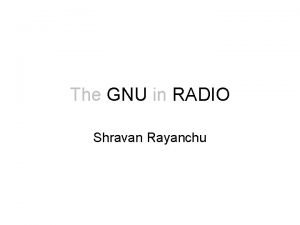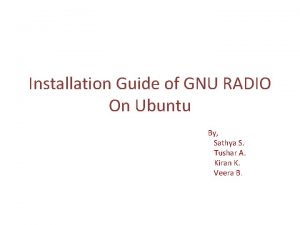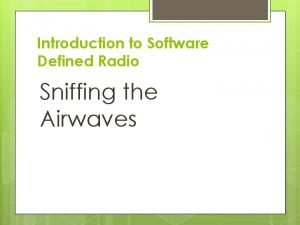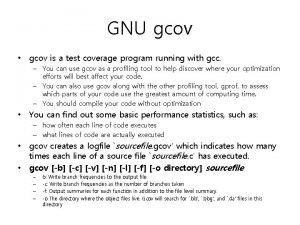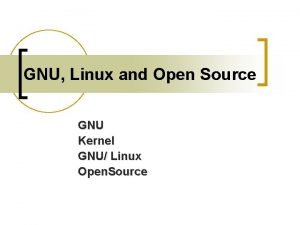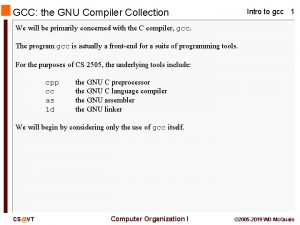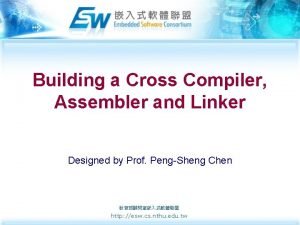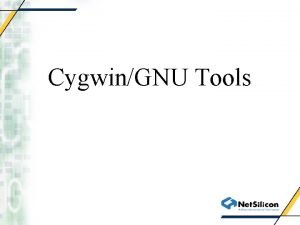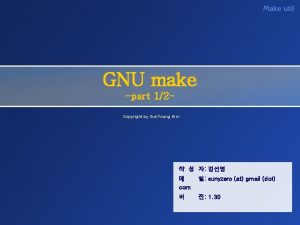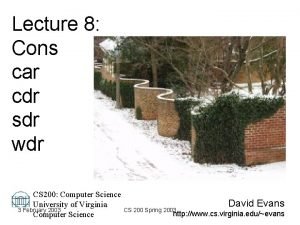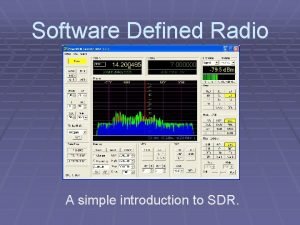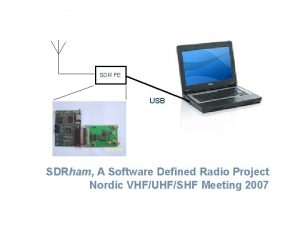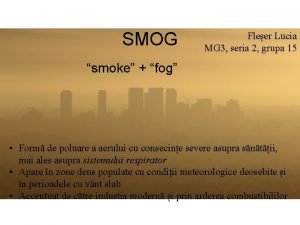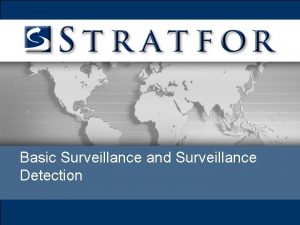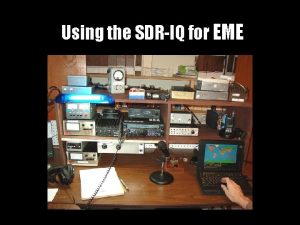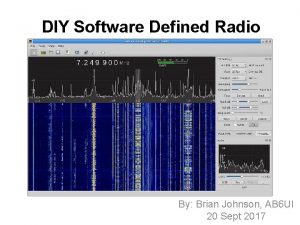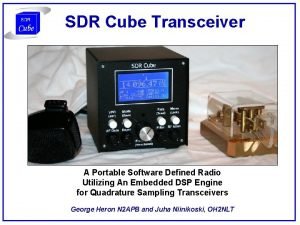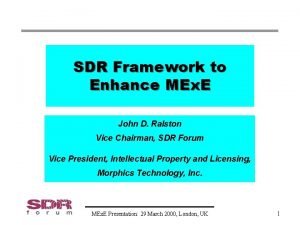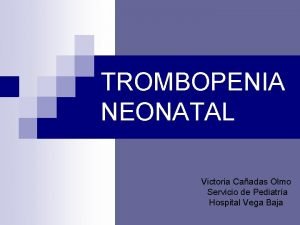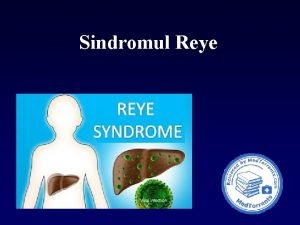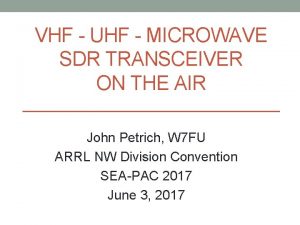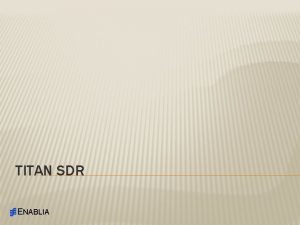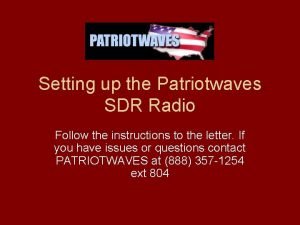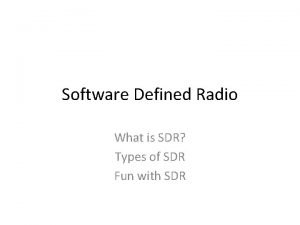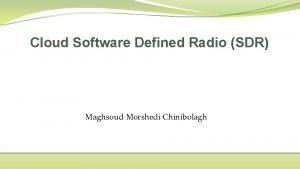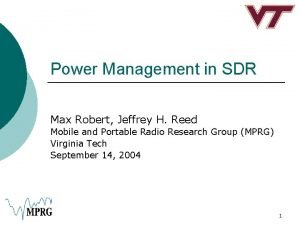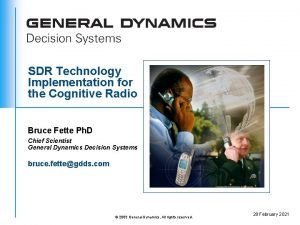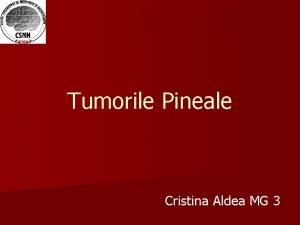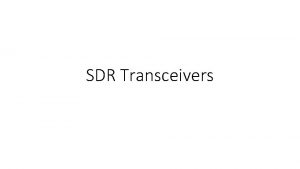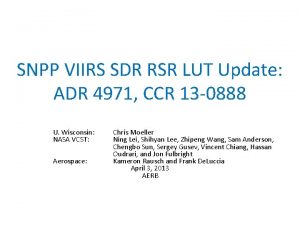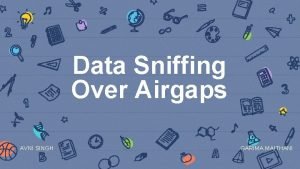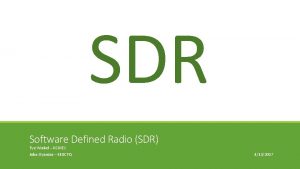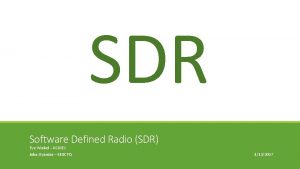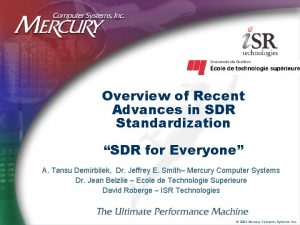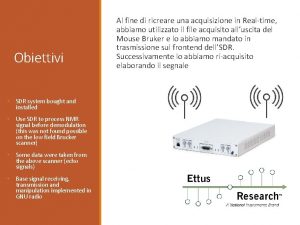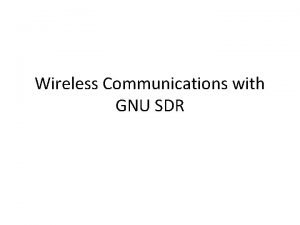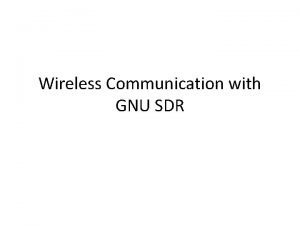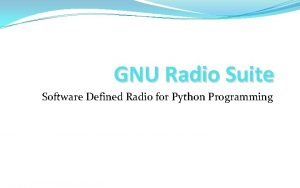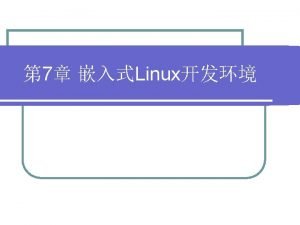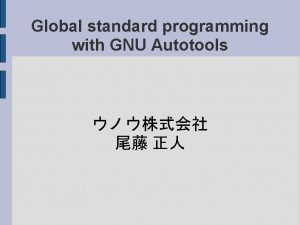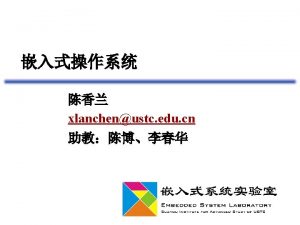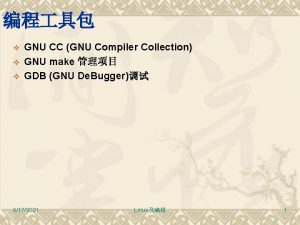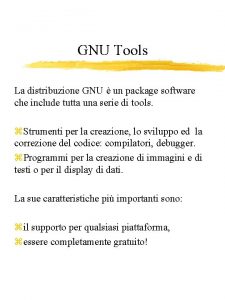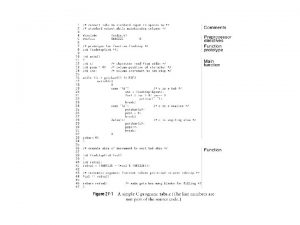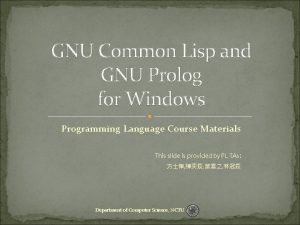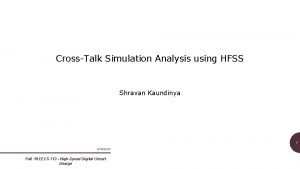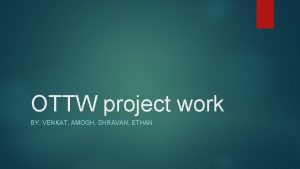The GNU in RADIO Shravan Rayanchu SDR Getting













































































- Slides: 77

The GNU in RADIO Shravan Rayanchu

SDR • Getting the code close to the antenna – Software defines the waveform – Replace analog signal processing with Digital signal processing • Why? – Flexibility, time to market, reliable – Its all about the stack : GPRS/ Wi. Fi / Wi. Max

SDR • Possibilities …? – TX/RX on multiple channels simultaneously – Better spectrum usage – “Cognitive radios” • Disadvantages – Higher power consumption (GPU vs ASIC) – More MIPS! – Higher cost (as of today)

GNU RADIO • Platform for – Experimenting with digital communications – Signal processing using commodity hardware • Free software! • http: //www. gnu. org/software/gnuradio/

A TYPICAL SDR

ADC • Sampling Rate – Rate at which you sample the analog signal – Determines what frequency can be handled • Dynamic range – Number of signal levels – Quantization error • SNR = 6. 02 N + 1. 76 d. B

Sampling Sum of sinusoids: Sigma ai Sin (2 pi fit)

Sampling Sin (2 pi fc nts) = Sin (2 pi fc nts+ 2 pi m) fc + k f s = Sin (2 pi nts (fc + m/n fs)) We need a LOW PASS FILTER !

Sampling

Nyquist Criteria Sampling freq > Twice the max. frequency component in the signal of interest

ALIASING ADCs in USRP: 64 Msps 32 Mhz How to receive 2. 4 Ghz ? RF Front end

RF Front End: Down conversion LPF ADC Intermediate Frequency (IF) VCO Mixer: sinusoid of (RF-IF)

RF Front Ends • • 50 - 860 Mhz RX 400 – 500 Mhz Transceiver • 2300 – 2900 Mhz Transceiver – Bandpass filter (2. 4 to 2. 483 Ghz)

USRP

USRP • Universal Software Radio Peripheral – To rapidly design powerful, flexible software radio platforms • What does it have? – FPGA (ALTERA Cyclone) – Mixed signal processor (AD 9862) – Slots for 4 daughter boards (2 TX, 2 RX)

Boot sequence: two programmable components • USB Controller (Cypress FX 2): 8051 code • FPGA (ALTERA Cyclone): Verilog

USRP • Four 12 -bit ADC, 64 Msps – Sub-multiples are also possible: 42. 66 Msps, 32 Msps, 25. 6 Msps and 21. 33 Msps – Decimation helps – IF has to be < 32 MHz • Four 14 -bit DAC 128 Msps – Max. output 50 Mhz • Four I/Os simultaneously if we use real sampling, Two I/Os for complex sampling; synchronized clocks • Each daughter board has access to 2 DACs and 2 ADCs • Why Different boards ? – different RFs same IF

USRP • Four Digital Downconverters (DDCs) – FPGA with CIC Filters – Programmable decimation rate – Low pass filter • Two Digital Upconverters (DUCs) – AD 9862 – Programmable interpolation rate • USB 2. 0 (480 Mbps, peak)

RX PATH

DDC : IF Complex Baseband

TX PATH AD 9862 Block D: The "Fine Modulator" -- this is a digital up-converter Block C: Interpolation filter (we interpolate by 4 in the AD 9862) Block B: The "Coarse Modulator" Block A: The actual DACs.

GNU Radio Software Architecture • Library of signal processing blocks (C++) – Ex: sources, sinks, others • Input, output ports, types, ‘work function’ • Create a ‘flow graph’ : vertices are blocks and edges represent the data flow (Python) • SWIG, FFTW, Boost …

Lets look into some code!

GENERATE DIAL TONE






Frequency Modulation







Spectrum Sensing

Spectrum Sensing

Spectrum Sensing

Spectrum Sensing

Spectrum Sensing

Spectrum Sensing

6 Mhz Limit • USB 2. 0 limit 32 MBytes/sec • ADC 64 Msps 32 Mhz chunk • 8 Msps w/ 16 bit I/Q samples – 8 * 2 = 32 Mbytes/sec – 4 Mhz * 2 = 8 Mhz (Quadrature sampling) – Discard 1/4 of bins ~ 6 Mhz • Decimation (8, 256) • Interpolation (16, 256)

Spectrum Mask

Spectrum Sensing Tune : 0. 001 sec , Dwell : 0. 1 sec , Step: 0. 5 Mhz , FFT : 1 Mhz wide

Spectrum Sensing Tune : 0. 001 sec , Dwell : 0. 1 sec , Step: 1 Mhz , FFT : 1 Mhz wide

Spectrum Sensing

Spectrum Sensing Tune : 0. 001 sec , Dwell : 0. 01 sec , Step: 1 Mhz , FFT : 1 Mhz wide

Spectrum Sensing Tune : 0. 001 sec , Dwell : 0. 01 sec , Step: 1 Mhz , FFT : 1 Mhz wide

CSMA


CSMA

CSMA

CSMA

CSMA Complex samples from USRP

CSMA Complex samples from USRP

Spectrum

CSMA Complex samples from USRP

CSMA Complex samples from USRP Filter to get the actual channel we want

CSMA Complex samples from USRP Filter to get the actual channel we want

CSMA Complex samples from USRP Filter to get the actual channel we want

CSMA Complex samples from USRP Filter to get the actual channel we want Demodulate to get ones and zeroes

CSMA Complex samples from USRP Filter to get the actual channel we want Demodulate to get ones and zeroes

CSMA Complex samples from USRP Filter to get the actual channel we want Demodulate to get ones and zeroes Get the SYNC Vector

CSMA Complex samples from USRP Filter to get the actual channel we want Demodulate to get ones and zeroes Get the SYNC Vector

CSMA Complex samples from USRP Filter to get the actual channel we want Demodulate to get ones and zeroes Get the SYNC Vector We have the pkt now

CSMA Complex samples from USRP Filter to get the actual channel we want Demodulate to get ones and zeroes Get the SYNC Vector We have the pkt now Carrier Sense RX CALLBACK

Some numbers. . • Time to switch freq ~ 0. 001 sec (Have to verify) • Modulation: – GMSK, [ DBPSK, DQPSK didn’t work ] – Bit rate = 500 k [ CPU Maxed out ] • Throughputs: – UDP: 520 kbps ! (PHY: 500 kbps) : Error in Netperf ? – TCP: 20 ~ 80 Kbps

Channel 1, less tries 2. 412 (Channel 1) , 3. 8% pkts in error

Channel 1, Ping flood, More tries

Channel 1, Ping source, More tries 4% error (throughput very less)

Channel 6 2. 3% pkts in error

2. 423 Ghz ~ 1. 6% pkts in error

2. 562 Ghz 0% pkts in error

Channel 1, Ping source CS_Thresh = 70 , 50 Error was ~ 4 % !!


What do we have? • Multiple modulations: – BPSK, QPSK, GMSK, QAM (soon) • • • Symbol rates / bandwidth Pulse shape filtering (? ) Carrier Frequency Power Payload size CRC. .
 Shravan rayanchu
Shravan rayanchu Gnu radio installation
Gnu radio installation Sdr radio
Sdr radio The secret to getting ahead is getting started
The secret to getting ahead is getting started Gnu gcov
Gnu gcov Gnu kernel
Gnu kernel What is gnu c
What is gnu c Gnu gcc is a: cross compiler assembler linker loader
Gnu gcc is a: cross compiler assembler linker loader Gimp gnu image manipulation program meaning
Gimp gnu image manipulation program meaning Gnu development tools
Gnu development tools Gnu 700 tractor
Gnu 700 tractor Make automatic variables
Make automatic variables Nrfl
Nrfl Gnu make pdf
Gnu make pdf Gnu dirty pillow 2014
Gnu dirty pillow 2014 Gary ganews
Gary ganews Gimp es las iniciales de:
Gimp es las iniciales de: Awin support
Awin support Cdr and sdr
Cdr and sdr Softrock sdr
Softrock sdr Sdr meaning
Sdr meaning Sdr x fragil
Sdr x fragil Torace in butoi
Torace in butoi Directed surveillance examples
Directed surveillance examples Sdr career path
Sdr career path J&t tracking
J&t tracking Diy sdr receiver
Diy sdr receiver Oh2nlt
Oh2nlt Sdr framework
Sdr framework Sdr wiskott aldrich
Sdr wiskott aldrich Sindromul reye
Sindromul reye Uhfsdr
Uhfsdr Titan sdr
Titan sdr Hdsdr setup
Hdsdr setup Sdr types
Sdr types Sdr
Sdr Sdr asperger
Sdr asperger Sdr tactical
Sdr tactical Sdr.max
Sdr.max Poslx
Poslx Sdr parinaud
Sdr parinaud Sdr transceivers
Sdr transceivers Moody sdr menu
Moody sdr menu Adr sdr
Adr sdr Sdr tempest
Sdr tempest Gengi sdr
Gengi sdr Amsat dl upconverter
Amsat dl upconverter Valvula de gubaroff
Valvula de gubaroff Vẽ hình chiếu vuông góc của vật thể sau
Vẽ hình chiếu vuông góc của vật thể sau Công thức tiính động năng
Công thức tiính động năng Phép trừ bù
Phép trừ bù Tỉ lệ cơ thể trẻ em
Tỉ lệ cơ thể trẻ em Thế nào là mạng điện lắp đặt kiểu nổi
Thế nào là mạng điện lắp đặt kiểu nổi Lời thề hippocrates
Lời thề hippocrates Vẽ hình chiếu đứng bằng cạnh của vật thể
Vẽ hình chiếu đứng bằng cạnh của vật thể đại từ thay thế
đại từ thay thế Quá trình desamine hóa có thể tạo ra
Quá trình desamine hóa có thể tạo ra Môn thể thao bắt đầu bằng chữ f
Môn thể thao bắt đầu bằng chữ f Sự nuôi và dạy con của hươu
Sự nuôi và dạy con của hươu Hát kết hợp bộ gõ cơ thể
Hát kết hợp bộ gõ cơ thể Các loại đột biến cấu trúc nhiễm sắc thể
Các loại đột biến cấu trúc nhiễm sắc thể Nguyên nhân của sự mỏi cơ sinh 8
Nguyên nhân của sự mỏi cơ sinh 8 Trời xanh đây là của chúng ta thể thơ
Trời xanh đây là của chúng ta thể thơ Phản ứng thế ankan
Phản ứng thế ankan Chó sói
Chó sói Thiếu nhi thế giới liên hoan
Thiếu nhi thế giới liên hoan Fecboak
Fecboak điện thế nghỉ
điện thế nghỉ Một số thể thơ truyền thống
Một số thể thơ truyền thống Thế nào là hệ số cao nhất
Thế nào là hệ số cao nhất Hệ hô hấp
Hệ hô hấp Số nguyên là gì
Số nguyên là gì đặc điểm cơ thể của người tối cổ
đặc điểm cơ thể của người tối cổ Các châu lục và đại dương trên thế giới
Các châu lục và đại dương trên thế giới Tư thế worm breton là gì
Tư thế worm breton là gì ưu thế lai là gì
ưu thế lai là gì Thẻ vin
Thẻ vin
